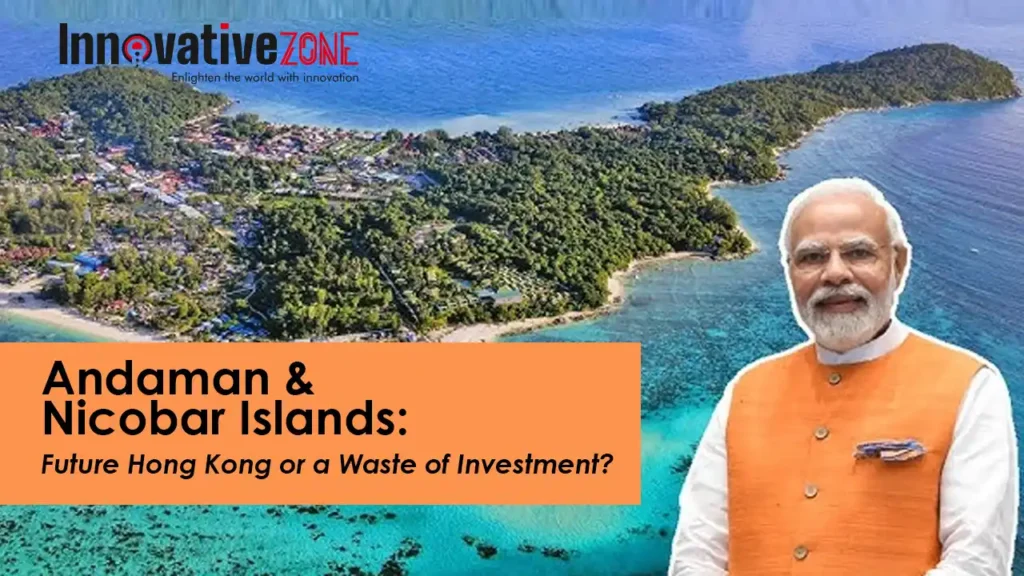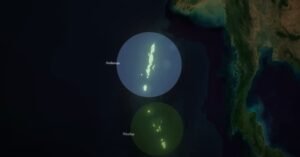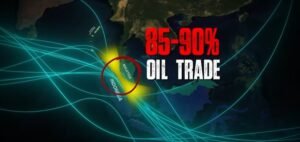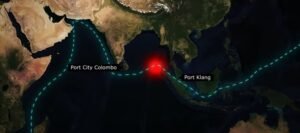Andaman & Nicobar Islands: Future Hong Kong or a Waste of Investment?
Written By: Anurag Tiwari
This small island of our country, the Andaman and Nicobar Islands, is soon set to become a modern city, much like Hong Kong. Yes, the Government of India has already launched a new ₹75,000 crore project for this. Now, hearing this news, any Indian would surely feel a sense of pride. I agree, but I have a few questions about this. First of all, Hong Kong is what it is because it is a financial hub and it is the world’s third-largest financial hub. This means that numerous businesses and multinational companies have chosen Hong Kong as the location for their headquarters. Moreover, Hong Kong is an extremely well-planned city. It is also Asia’s second-largest tourism hub.
This is a union territory made up of 836 islands, of which only 31 are inhabited. The remaining 805 islands are filled with dense forests and desolate caves. The people who live on these 31 islands are mostly members of indigenous tribes, many of which are still hunters and gatherers. In present times, they primarily sustain themselves by selling coconuts, fishing, and hunting animals.
There are 28 states and 8 union territories in India. Our country has around 51 metropolitan cities, but leaving all of these aside, why does the government want to spend ₹75000 crore to make only the Andaman and Nicobar Islands into Hong Kong? This ₹75,000 crore is a huge amount, more than double the GDP of an entire state like Arunachal Pradesh. So, what is it about the Andaman and Nicobar Islands that India has decided to establish such a large project here rather than in any other state? And another thing, it’s not that we are just talking about developing the relatively underdeveloped areas of Andaman further. Look at this map, this entire region is Andaman and Nicobar.
As of today, the Andaman Islands are comparatively more developed, with major tourism and government offices. But do you know which part of the entire Union Territory is being developed? It’s for a small area called “little Andaman,” which, mind you, is still 90% covered in forests and remains undeveloped. So, instead of further developing an already developed region, why does the government want to start from scratch and develop a completely barren, untouched area?
The third question, as I mentioned earlier, is that the government’s plan is to turn this small region into a financial hub similar to Hong Kong. But if we talk practically, how is this possible? As I pointed out, the majority of the local population in the Andaman and Nicobar Islands are tribes. So, who is going to establish startups and multinational companies in this region? To make this happen, we would need to attract not just entrepreneurs and MNCs from within the country but also from abroad.
And those companies have cities like New York, London, and Tokyo, which are ultra-modern mega cities equipped with all the modern amenities. So, how will our small “Little Andaman” compete with these giants? Is there any unique advantage that Andaman offers that no other city in the world can provide today? And well, the answer is—yes.
But if the Andaman and Nicobar Islands are developed properly, it could become a strategic port that no other country in the region can have. and because of this region, many countries stand to gain millions of dollars. And, of course, India could benefit even more, potentially gaining billions of dollars.
First, let’s understand that the entire project is not being built only in Little Andaman. A large part of it is indeed being developed in Little Andaman, which, as I mentioned, is 95% surrounded by dense forests. However, a phase of this project is also taking place in the Nicobar Islands, where there is a plan to develop Galathea Bay as a strategic transshipment hub. Take a close look at this map.
You may already know that globally, 90% of the oil trade still happens solely via this sea route. 90% of the oil trade, which is still considered the ‘gold’ of the modern world. Imagine if a ship from China is carrying goods to Oman, but it also needs to unload goods in Myanmar, Bangladesh, India, and Sri Lanka along the way. In a normal case, this ship would stop at each of these locations to unload its cargo, right? This takes a lot of time and incurs significant costs. However, this is where the strategic location of Galathea Bay will provide a major advantage to India.
Because this bay is located right in the center, this means a ship can come directly from China, stop here, unload goods for all the neighboring countries, and then head straight to Oman. These countries can then collect their respective shipments directly from Galathea Bay.
Now, it’s not that there are no other transshipment ports in the region. Sri Lanka has the Colombo port, and Malaysia has the Klang port, both of which are transshipment hubs. But if you look at their locations, these ports are on the edges of the shipping route, not in the centre.
Why is this so important? Because typically, when shipping goods, companies have to pay daily costs, which can go up to around $200,000. If ships have to travel even an extra 100 nautical miles, it increases the daily costs for companies by thousands of dollars.
Therefore, according to estimates, if our transshipment hub is established at the very centre of the region, in Galathea Bay, the shipping costs for all countries will be reduced by almost 15%. This means companies could potentially save up to $30,000 a day.
Now, regarding India, in my opinion, it’s a huge mistake for India that we haven’t utilized this opportunity so far. We have not yet leveraged the strategic location of Galathea Bay. But before we understand that, here’s another interesting point—this project could also be a great opportunity for entrepreneurs and investors from Hong Kong and India, especially for those interested in the hotel and restaurant sector. The hotel industry in India is considered one of the most profitable industries.
How is it a huge blunder for India that, despite having the opportunity, we haven’t leveraged the strategic location of Galathea Bay so far?
This is causing us a loss of at least ₹1500 crore, or 180 million dollars, every year, while smaller countries like Sri Lanka and Malaysia are earning millions of dollars by developing their ports. Yet, we are still incurring losses.
Now, the second aspect that makes this entire project so interesting is the plan to transform the Little Andaman region. It’s interesting because we don’t just want to make this region a new financial hub for India; we want to turn Little Andaman into a livable, well-planned financial hub.
Just like Hong Kong, if you look at other metropolitan cities in our country today, such as Delhi, Mumbai, etc., large skyscrapers have been built where millionaires live, but right next to them, there are dangerous factories. For example, in BKC, there are business hubs, but right next to them, there are slums. The whole city feels unplanned and unmanaged. However, this mistake will not be repeated in Little Andaman, and the reason for this is that the NITI Aayog has launched a project called Sustainable Development of Little Andaman Island, through which this region will be redeveloped from scratch.
This project is planned in three zones — Zone 1, Zone 2, and Zone 3. Let’s start with Zone 1 first. This is very interesting because, to attract entrepreneurs and businesses to any city, the first important thing is connectivity, right? But the problem is that currently, only ships can reach Little Andaman, and there is only one ship, MV Nalanda, with no fixed schedule. It may travel one day, but the next day, there is no guarantee it will go. Additionally, there is only one helipad here, which cannot handle much traffic.
In Delhi, near Indira Gandhi Airport, there are several commercial buildings such as Industrial Bank of Korea, Japan Bank for International Cooperation, and World Mark 2, all located at very close distances to each other. This is the reason why Aero City has been so successful. Even though IGI Airport in Delhi operates at a loss, because Aero City is part of the same parent company, the profits from this Aero City cover the losses of the airport. Aero City has remained profitable because businesses prefer such locations where airports and offices are in close proximity.
Now, the situation in Little Andaman is different—currently, it is a barren land surrounded by forests. But since we want to develop Little Andaman into a well-planned city, the plan is to create separate zones for a Residential District and a Financial District. The blueprint for this is inspired by the South Residential District of Dubai.
However, let’s assume that this project does succeed, but the problem will still be that Little Andaman, being 1400 kilometers away from mainland India, is somewhat disconnected. Therefore, in any emergency, bringing medical facilities from mainland India would be very difficult. Moreover, as of today, there are only three government hospitals in this entire union territory, with a total bed capacity of just 1,200 beds.
Now, if you were to move to a new city, you would want the medical facilities and health infrastructure to be top-notch. That is why the second major plan of this project is to build a medical city in Zone 1, just like Dubai’s visionary King Maktoum bin Rashid Al Maktoum did in Dubai in 2002.
So, what have we learned from Dubai? First, in Dubai, a hospital named The City Hospital was built in that area. Then, the Sheikh reserved several acres of land around that hospital solely for medical use. Additionally, in many countries, if you are a foreign national, you are not allowed to buy land in that country. But the King of Dubai opened up this area and announced that no matter what your nationality is, you can now buy land in this reserved area and build your medical facility. He also declared this area a tax-free zone, meaning 0% tax.
This is a very significant move because, for example, a normal Apollo Hospital pays around 200 to 3,300 crore rupees annually in taxes alone.
But the King of Dubai announced that if you open a hospital in this region, you won’t have to spend a single penny on taxes. Thanks to these facilities, within just a few years, this entire area in Dubai became a medical hub, and medical tourism in the region grew significantly. If you look at the data from last year, 691,000 medical tourists visited Dubai, bringing the UAE a profit of 1 billion dinars, all within just one year. This was 2.5 times more than in 2022. Similarly, in Hong Kong, Disneyland was built to boost tourism, and it succeeded. According to last year’s data, Disneyland brought in about 69,000 crore rupees in profits for Hong Kong.
In addition to this, Hong Kong’s casino strip also contributes significantly to their GDP. Gambling is only legal in Hong Kong in China, and you won’t believe it, but Hong Kong’s casino strip contributes 50% to their GDP. This is why there is a plan to create a casino strip in Zone 2 of Little Andaman, which could further boost the region’s tourism economy. If you observe, only Sikkim and Goa have legal casinos in India, and last year, casinos in Goa earned a profit of 820 crore rupees.
Another thing you might have noticed is that in Bollywood films, beach scenes are often shot in foreign countries like the Maldives, Thailand, Mauritius, Spain, and even Dubai. Many times, the budget for a music video alone can run into crores. But now, a National Film and Drama Institute will be established in Zone 2 of Little Andaman, along with outdoor filming locations, music video shooting areas, and a film sound and music studio for dubbing.
There is an effort to create an alternate film city in Zone 2, specifically a beach-themed film city, which would be a unique selling point for Little Andaman.
Additionally, another unique selling point of Little Andaman is its lush green forests. The region is home to many rare plant and animal species. It is also one of the few places in India where you can see coral reefs. This could be a perfect destination for tourists who seek peace away from the noise of the city, in the middle of dense forests. Therefore, under this project, Zone 3 is planned to be developed as a nature-exclusive zone, inspired by Hong Kong’s Dragons Back Trail and Titan Country Park, which are famous for providing nature-exclusive zones amid cities.
Similarly, a plan has been made for Little Andaman, where a 52 square km land reserve will be set aside.
Now, while the project plan looks very promising, some Indian activists view it as ecocide—the destruction of the environment. They argue that the region is covered by 95% evergreen forest, and this project would require the cutting down of 2.44 million trees. Secondly, removing the forest cover would disrupt the local animal ecosystem, especially the famous giant leatherback sea turtles of Andaman, which are an endangered species found in only a few places. These turtles come to Little Andaman because it is one of their primary nesting sites.
The third major concern is about the indigenous tribes living in the area, especially the Onge Tribes. The project plan states that they will be relocated, but no detailed information has been provided about this relocation.
These concerns are certainly genuine, but another perspective on this issue could be that if Little Andaman is not developed, it could become a major national security threat for the country. If you zoom out a little, you will see that in the entire Indian Ocean and the Strait of Malacca, countries like China, Australia, France, the US, and Russia have military bases. Several countries have even established their military bases in the region.
As I have discussed in my previous videos, major countries have tried to increase their influence in the Indian Ocean region, because they understand that the country that dominates this region will likely dominate the world in the future.
In every war, the battle is not just fought on the battlefield, but both military power and economic power play critical roles. For India, economic power in particular is crucial.
If you observe, about 85–90% of global oil trade passes through this region, and the Indian Navy demonstrated during the Galwan clash with China how blue-water diplomacy can lead to significant strategic successes.
Now, we need to see how Little Andaman develops, according to our ecological and economic principles, and whether we can achieve sustainable development in the region.
What are your thoughts on this project and the Hong Kong model? Feel free to share your thoughts in the comments below. Reference Links to our Research: Click Here: ___ Andaman & Nicobar Islands: Future Hong Kong or a Waste of Investment?
Disclaimer: The views expressed by the writer do not reflect those of Innovativezone. InnovativeZone India Magazine does not endorse the opinions presented in this piece.





